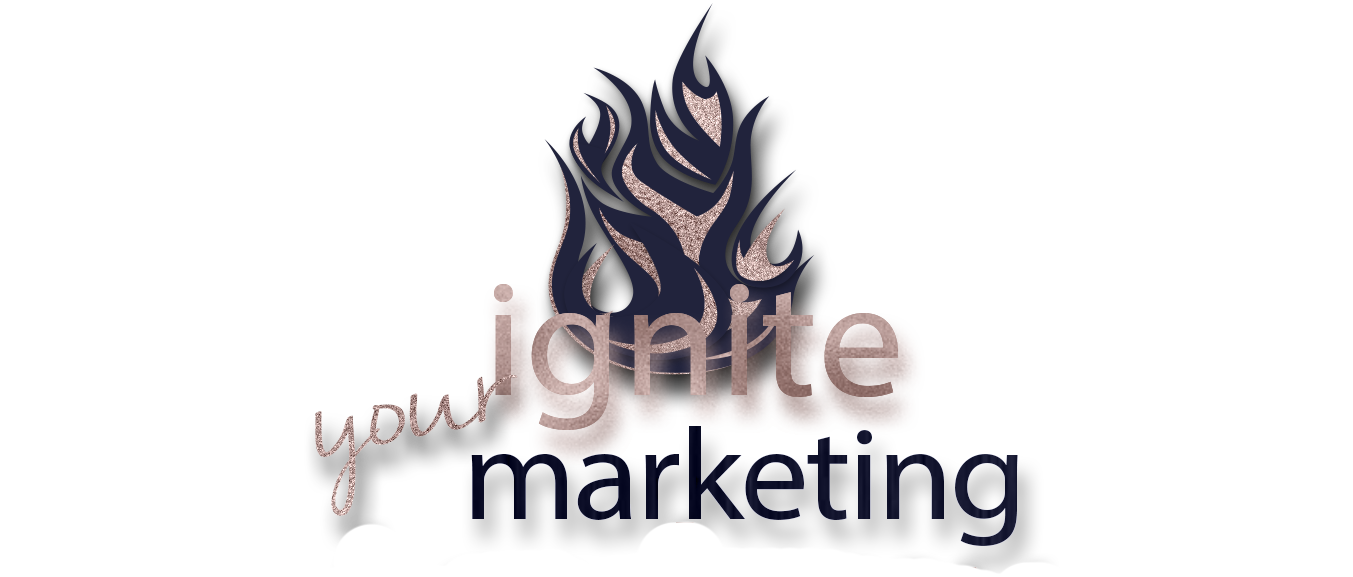
15 Jan Was Your Funnel a Flop?
As we roll into the new year I know many of you are feverishly planning on launching a new product, course, or new service packages. With each new launch comes a funnel. When it comes to funnels they can be as simple as two pages or as complicated as a multi-page funnel, an order form or two, a couple order bumps, a multi email automation sequence and so on.
It doesn’t matter how difficult your funnel is what does matter is, is the funnel working or not? This is key when it comes to determining if your paid ads are paying off, if your offer needs tweaked or not, or if you need to dissect your funnel to plug some leaks. Today I am going to teach you some basic funnel math to help you determine if your funnel is a flop or not!
The first thing you need to understand is sometimes when you’re first running ads, your ad costs can be higher. This can be for several reasons either you’re just starting out with ads and you haven’t really mastered the skill, your target audience needs adjusting or due to the fact of the type of industry or niche you are in. When this happens you often times feel like the funnel isn’t working because all of the money you are making is going right back into the pockets of the ads platforms. And when I say ads it doesn’t matter what platform you are running paid ads on, it all is the same.
Now let’s take just a moment to shift your expectations when it comes to funnels and funnel conversion (okay take a deep breathe) as I walk you through a simple exercise to do some quick and painless funnel math to determine how well your funnel is really functioning.
For this exercise I am going to walk you through a simple 4 page funnel. In this funnel we will have the following:
- Squeeze Page (Freebie)
- Offer Page w/ order bump
- OTO (One-Time-Offer)
- Final Thank You Page
To follow along download this simple handout I created to walk you through this exercise.
As you will see on this worksheet we have three boxes. In the first box I want you to write FREE.
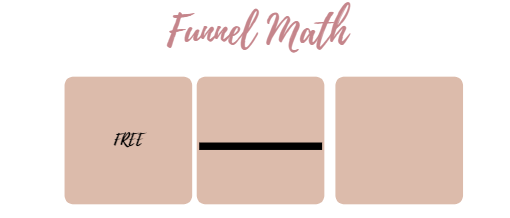
This first page is going to be your squeeze page this is the page where you are going to offer something of value to your audience in exchange for their email address.
The second page is going to be your thank you page but instead of just saying thank you and moving on. You are going to do what any savvy digital marketer would do you are going to place a low cost offer on this page. This can be presented to your audience as a one-time discount on something you are already selling, this could be a product or service that you only offer here (that can’t be bought on your site) etc.
So box #2 is going to be your Thank You Page with a one-time offer. Let’s say for our example we are going to offer your lead a $37 product. In box #2 I want you to write $37. Now, if you are working with a strategist like myself we would suggest that you offer another offer to your customer in the form of what we call an order bump.
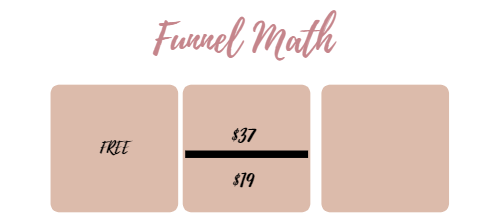
An order bump is a great way to increase your customer value very simply. You see when you get someone to commit to pulling out their wallet and saying yes to your first offer often times it is even easier to get them to purchase the order bump (or add-on) offer. How we do this is we present this offer as a box at the bottom of a checkout form that they have to check or leave unchecked depending on if they want it or not. So for our purpose let’s say your order bump offer is $19.

Once they have said yes to your initial offer of $37 and they decided whether they wanted your order bump or not. We then present them with an OTO or one time offer. We do this by simply presenting a page that says, wait, your credit card is being processed. But before you go, I have a one-time offer. Click YES or NO to buy. For our funnel let’s pretend that you have an OTO for a product that is $57.
So now on your handout you should have a box that says free, a box in the middle that says $37 with an order bump at the bottom of the box that says $19. Then the third box which is the one time offer which should say $57.
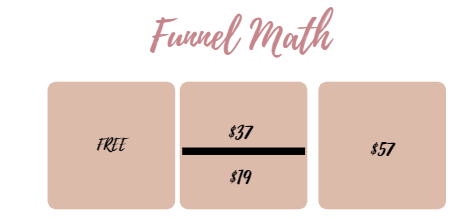
Now, here is where we do the math. You want to figure out if your funnel is profitable or on the track to being profitable. First you need to understand what is “normal” benchmarks when it comes to funnel conversion. When I say normal each industry can be a little different and once you have a few funnels under your belt you will have some benchmarks for yourself. But for now we will use some industry averages to figure this out.
For the first box on your free offer it is pretty normal to have somewhere between 20%-30% opt-in rate.
So for every 1000 people that visit that page to have an opt-in rate of about 200-300 people is industry standard. Anything under 200 is low and anything over 300 is high.
So under box #1 I want you to write 20-30%.

For the middle box, our offer page. This is where you are selling that $37 product. Industry standard for this page is going to be anywhere from 1%-5%.
So for every 200-300 people that came through on the first page only about 2-10 people (on the low end) are going to purchase that product. This is where we need to place some realistic expectations. At this point in the funnel people seem to think that 10%, 20% or (gasp) 50% is a normal conversion rate but this simply isn’t the case.
Alright let’s now focus on the the order bump on your offer page. And guess what when it comes to this conversion rate it is actually closer to a 40% conversion but for this example let’s bump it down to be 20%-30% to be moderate in our averaging. The reason this conversion rate is higher than the offer is because psychologically when you get somebody to say yes, it’s easier to get them to say yes again.
So under the middle box I want you to write 1%-5% on the top line and on the bottom line I want you to put 20%-40%.
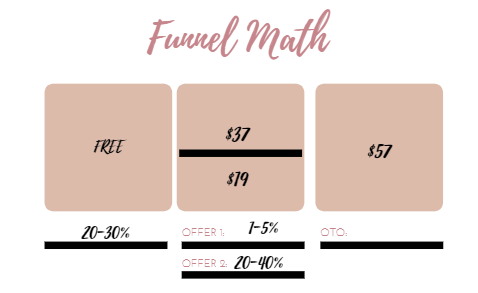
Moving on to the OTO page it is safe to say that about 3%-10% of the people that purchased your offer will also purchase the OTO. So under box #3 I want you to write 3%-10%. If you take a step back and look at our funnel the initial $37 offer in our funnel is the hardest part of the funnel to convert.
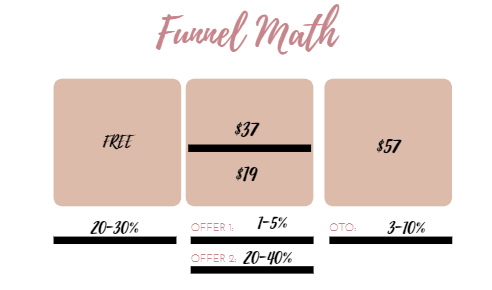
Okay, now for some funnel math fun let’s say you get 5,000 people to see your squeeze page, This is 5,000 pairs of eyes on your free you should see about 1,500 people (at 30%) opt in to the free offer.
Now we have 1,500 people who are now looking at your offer page with your $37 product on it. We said in our estimates about 1% – 5% will purchase this offer. So this will be 15-75 people who purchase this offer. With this purchase right here you have pocketed $555 – $2,775.

Awesome! So now you have made a little change on your first offer let’s take a look at your order bump. We can assume that about 20%-40% of the people who said yes to your first offer will now say yes to your second offer (order bump). This will net you another $285 – $1,425. Awesome so your total so far in income should be $840 – $4,200. Awesome right? But wait we still have one more offer to work through…

Let’s take a look at your OTO offer. Now, we can assume that this offer will convert at about 3%-10% generating you another $114 – $399. Netting you a total of $954 – $4,599. Now let’s say for the sake of being optimistic that your funnel converted on the higher end of the scale and we round it out to about $3,500.
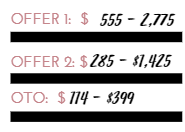
Now the big question is, does this mean the funnel is working? Well yes, based on our percentages and income generated the funnel is working and working at a decent conversation rate. The reason people don’t think the funnel is working is because when they are paying to send traffic to that funnel via ads they are shocked to see how much it actually costs them to send that traffic to the funnel.
Let’s take a look at that shall we? We started off by saying we have 5,000 people looking at the free offer. So let’s assume that you are running ads on Facebook and it costs you about $0.60 per click. So for every 5,000 people Facebook is charging you $3,000 to send traffic there. But we only made about $3,500 from the funnel. This is where people think they have a funnel problem when in reality they have an ads problem. They need to go back and figure out how they can reduce the costs per click. By our analysis the funnel works, it totally works. The problem here isn’t with the funnel at all. Often times they can go back and tweak the audience and get a drop in their per click costs. Let’s say you did just that. You adjusted your audience and are now paying $0.40 per click. I know, I know it is only $0.20, right?
Just hear me out if you do the math 5,000 clicks at $0.40 now costs you $2,000 instead of $3,000. You just put another grand in your pocket. Say what?!? What if you got your per click costs down to $0.30? Your total ad costs would be $1,500 saving you another $500 from just a $0.10 decrease in your per click costs thus generating you $2000 from your funnel. So essentially you are profiting $2,000 for every $1,500 you put into. It’s not quite doubling your money but it’s close. I would do this any day of the week, who wouldn’t.
Many people stop and give up in the begging when you were getting $0.60 a click and say this funnel is a failure because the slim margins. What they don’t sit down and do is the math to determine what is the conversation rates I am getting and are they normal. If they are normal then they need to figure out a way to reduce the ads costs. If the conversion rates are below normal they then need to go back and look at the funnel and see where they need to make some adjustments.
Are you looking for some killer marketing strategies for your business? We would love to chat!! Book a free marketing strategy session now! Book My Strategy Session Now!
